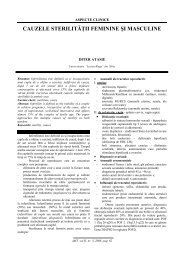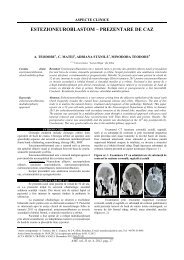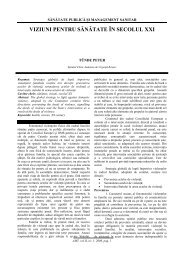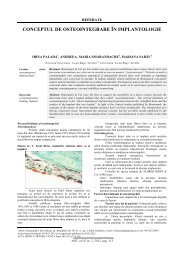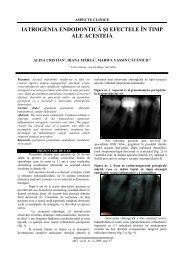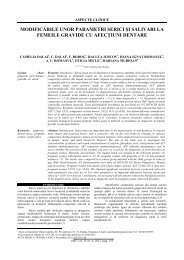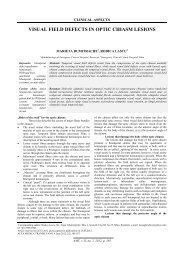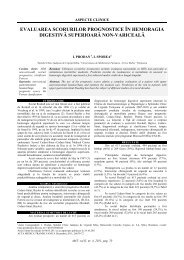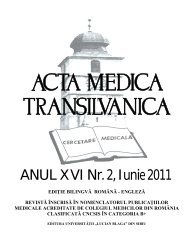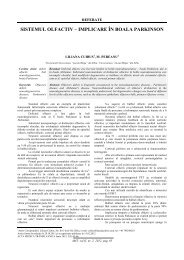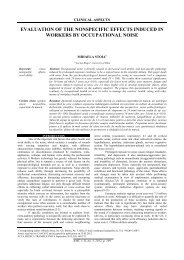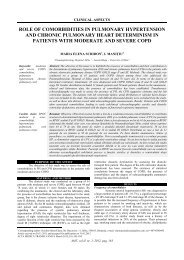Engleza nr 3-2011 - Acta Medica Transilvanica
Engleza nr 3-2011 - Acta Medica Transilvanica
Engleza nr 3-2011 - Acta Medica Transilvanica
You also want an ePaper? Increase the reach of your titles
YUMPU automatically turns print PDFs into web optimized ePapers that Google loves.
CLINICAL ASPECTS<br />
popularized this variation of the anastomosis, in order to shortcircuit<br />
the digestive segment, the first cases involving injuries or<br />
doudenal or gastric ulcer (1). The name comes from the<br />
similarity to a capital Y on schematic representation (Figure 1).<br />
The use in of bariatric surgery has been adopted in<br />
order to avoid adverse effects of a gastric reservoir anastomosis<br />
with the omega-type loop by Griffen (2). Positive results leaded<br />
to the wide addoption, especially in the U.S., where it is the<br />
intervention of bariatric surgery most often used today.<br />
Figure no. 1. Structure from gastric bypass (graphics by<br />
A. Popenţiu)<br />
patients;<br />
• Articular disease (lumbar diseases, artrodinies) improves<br />
spectacularly;<br />
• Circulatory phenomena of venous insufficiency (edema) -<br />
partially remitted.<br />
Improving co-morbidities (diabetes, dyslipidemia,<br />
hypertension, etc.) finally results in increased life expectancy,<br />
increased quality of life and a decrease in expenses related to<br />
health and social care. A study in Sweden on a group of obese<br />
diabetic patients showed a 80% reduction of annual mortality in<br />
patients who underwent bariatric surgery interventions,<br />
compared to a control group (6). Obese patients with diabetes in<br />
the group treated with surgery had a mortality of 9% at 9 years,<br />
compared with the control group, where mortality was 28%,<br />
with most deaths related to cardiovascular disease.<br />
MacDonald et al presented a study that patients with<br />
diabetes treated with oral hypoglycemic agents has a mortality<br />
rate of 4.5% for a period of 9 years of follow up, compared with<br />
only 1% for diabetic patients who underwent gastric bypass<br />
intervention (7).<br />
This intervention can be done entirely by laparoscopy<br />
and it was made for the first time in 1993 and Clark Wittgrove.<br />
Adapting mini invasive techniques has increased the popularity<br />
of the method, which is currently bariatric surgery most<br />
commonly used worldwide (3).<br />
Before the deveplopement of minimally invasive<br />
techniques, the Roux-en-Y gastric bypass was performed in<br />
many centers by classical approach, with good results on weight<br />
loss and acceptable peri-and postoperative complication rates.<br />
Results related to anastomotic dehiscence rate and<br />
other intra-abdominal complications are relatively comparable<br />
with data from the groups where the intervention was performed<br />
by laparoscopy, but reduced parietal complications and length of<br />
stay - shorter recovery, and reduced pulmonary complications<br />
percentage is favoring the laparoscopy.<br />
At present, issues related to costs involved are well studied, but<br />
although on short-term the laparoscopic interventions<br />
themselves are significantly more expensive, the benefits related<br />
to shortened hospital stay and faster socio-professional<br />
reintegration compensate for this relative disadvantage.<br />
Communicated results in literature<br />
In a retrospective study on a sample of 10,000 patients who<br />
underwent a gastric bypass, Griffen et al (4) obtained the<br />
following results: over 85% have lost at least 50% of excess<br />
body weight, and from 5000 patients followed by a period of 10<br />
years, 80% maintained this results.<br />
Another study followed 608 patients who were<br />
monitored for up to 14 years (5), and had a mean weight loss of<br />
75% at one year, but decreased to 50% by the eighth year.<br />
Positive metabolic effects are most representative<br />
image of improvement in comorbidities in patients from the<br />
studied groups:<br />
• Dyslipidemia is improved by over 70% of patients;<br />
• Essential hypertension is resolved over 70% of patients and<br />
for the rest the ammount of needed drugs to control it is<br />
much lower;<br />
• Type 2 diabetes is cured in up to 90% of patients, blood<br />
sugar values returned to normal very quickly,<br />
• Obstructive sleep apnea may disappear completely or be<br />
improved;<br />
• Gastro-esophageal reflux disease may disappear in most<br />
AMT, vol II, <strong>nr</strong>. 3, <strong>2011</strong>, pag. 368<br />
CONCLUSIONS<br />
Obesity currently reaches a global pandemic size,<br />
which raises serious medical, social and financial issues,<br />
including our country. Obesity and overweight induce an<br />
increased risk of developing chronic diseases such as type 2<br />
diabetes, cardiovascular disease, hypertension, cardiovascular<br />
disease and some cancers. Mixed surgical methods with<br />
restrictive and malabsorbtive components, are most commonly<br />
used with good results in terms of weight loss and low rate of<br />
complications<br />
BIBLIOGRAPHY<br />
1. C.Roux: De la gastroenterostomie. Revue de chirurgie,<br />
1893, 13: 402-403;<br />
2. Griffen W O, Bivins BA, Bell R M et all, Gastric bypass<br />
for morbid obesity, World J Surg, 1981; 5:817-22;<br />
3. Torres JC, Oca CF, Garrison RN. Gastric bypass: Rouxen-<br />
Y gastrojejunostomy from the lesser curvature. South Med<br />
J ;76:1217–21,1983;<br />
4. Griffen WO. Gastric bypass. In: Griffen WO, Printen KJ<br />
eds. Surgical management of morbid obesity. New York,<br />
NY. Marcel Dekker, Inc, 1987:27-45;<br />
5. Pories WJ, Swanson MS, MacDonald Kg et al. Who would<br />
have thought it? An operation proves to be the most<br />
effective therapy for adult onset diabetes mellitus. Ann<br />
Surg 1995; 222:339-52;<br />
6. Sjostrom C D, Lisnsner L, Wedel L H, Sjostrom L,<br />
Reduction in incidence of diabetes, hzpertension and lipid<br />
disturbances after intentional weight loss induced bz<br />
bariatric surgery. SOS Intervention Study, Obes Res<br />
1999,7, 477-484;<br />
7. MacDonald K G, Long S D, Swanson M S et al; The<br />
gastric bypass operation reduces the progression and<br />
mortality on non-insulin-dependent diabetes mellitus; J<br />
Gastrointest Surg ,1997;1;213-220.



